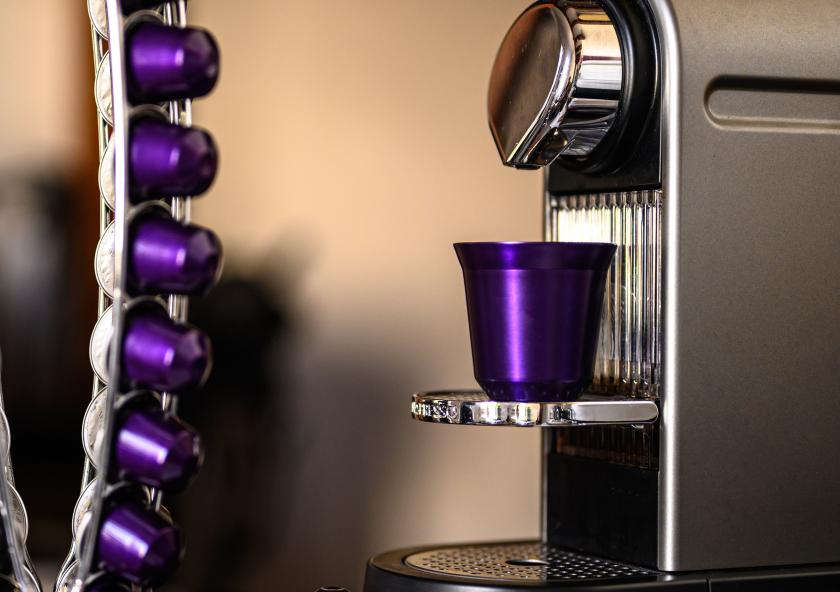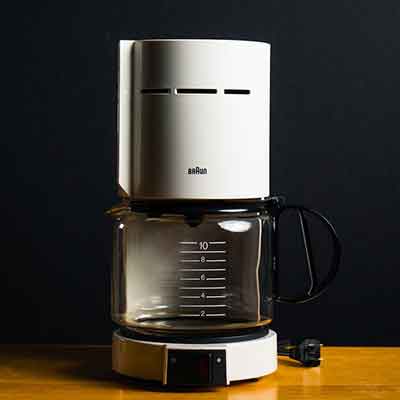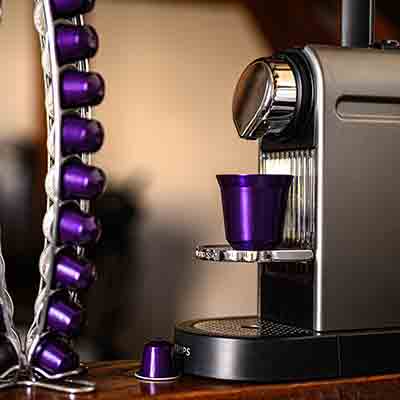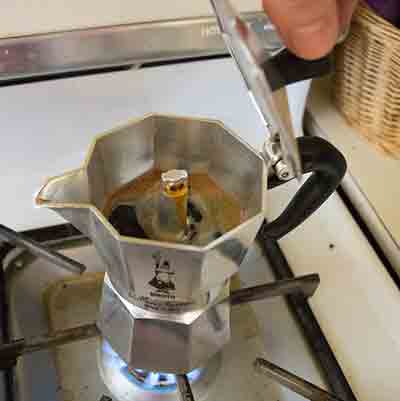
Stuff versus Stuff: Battle of the coffee makers

How do you get your morning coffee? Sometimes the options for brewing a cup of joe seem endless.
Welcome to Stuff versus Stuff, a mini-series where we explore the sustainability impact of our everyday product choices. In our first edition, we’re going to explore the impact of our coffee habits on environmental and ethical issues.
Here are the coffee-making contenders:
With 75% market share, the automatic drip coffee machine is ubiquitous in the US. The machine boils water and lets it flow through coffee grounds, filtered by paper or mesh, to fill a jug with up to 12 cups of delicious coffee.

The single-serve coffee machine is coming for the coffee crown, gaining a lot of popularity over the last decade thanks to companies like Keurig and Nespresso. Their popularity is driven by the convenience of being able to choose your coffee pod, fill the water jug and letting the machine do the rest.

Next, there’s the compact coffee makers, starting with the French press. It’s a budget-friendly gadget that simply captures coffee grounds once they have been steeped in hot water. They come in multiple sizes and last for years.

Our final compact coffee contender is the stovetop coffee maker or moka pot, an Italian invention where water is boiled and bubbles up through coffee grounds to collect at the top of the pot.

What is the impact of your coffee maker?
If you dismantled each of our four coffee brewing options, you would find many similarities. For the drip coffee and single serve machines, you’re likely to find a plastic (polypropylene) shell, some small steel and aluminum parts, electronics, LEDs and a heating element. In the case of the drip coffee machine there might be a filter and a Pyrex jug; materials it shares with the French press. The stovetop machine is even simpler, usually primarily made from aluminum and steel.
The fascinating part is that the environmental impact of the manufacture of a coffee machine is minuscule compared to its usage. A 2013 analysis of a sample drip coffee machine found that if the machine is used to make coffee once a day for five years, that power usage would make up 89% of the energy expended on the machine over its lifetime, including manufacturing, shipping and disposal!
So what about usage? According to Energy Star, average usage of a full-size drip coffee machine will use 100-150kWh per year – emitting greenhouse gases approximately the equivalent to driving 263 miles. In comparison, similar usage of a single serve pod machine uses about 45-65kWh per year, or 114 miles driven.
Why the difference? A big contributor to a drip machine’s energy consumption is the fact that it usually stays on to keep the coffee hot. A single serve machine, on the other hand, is only active for a short period of time but energy usage will scale linearly with the number of cups made.
How does this compare to the compact coffee makers? It depends on how you boil your water. If you use an electric stove, you could be using 185kWh per year. You can reduce this by using an electric kettle which is much more efficient at about 28.6kWh per year. The energy required to make a single cup is about the same as filling the coffee maker, so larger batches will lead to lower energy usage per cup.
However, the way you make your coffee is just one part of the story.
What is the impact of your coffee beans?
An analysis of 56 Brazilian coffee producers found that every 2.2 lb of coffee produced required approximately 2.75 gallons of water and 10.67 Megajoules of energy to produce. This varied greatly based on the practices of the grower, their location and the source of their electricity.
As a consumer, how can we tell if farmers are being efficient? Short of flying to a coffee farm yourself, you can check for certifications. An example of this is the Rainforest Alliance/UTZ standard which has 119 criteria for reducing farming waste and treating farm workers ethically, though only 37 are required for certification. Many major brands use certified coffee, but you need to check individual products for the certification stamp.
Certification only covers the growing of the coffee beans – they are usually exported raw to be roasted and processed closer to the consumer. The global average price a farmer will get per kilogram (about 2.2 lb) of beans is $2.93USD, but same weight of roasted beans will retail for between $15-25 whole, or $50-150 in capsule format.
Due to variation in proprietary processes, it’s difficult to find specific information on the overall environmental impact of a given brand of coffee bean. However, it’s estimated that on average there’s a 16.5:1 ratio of the weight of CO2 equivalent greenhouse gases emitted across the lifecycle of coffee beans versus the actual weight of the coffee itself (see more here).
What does that mean for your actual cup of coffee, though? A drip-based system (drip machine, Keurig etc.) uses about 0.25-0.42oz of coffee per cup, the French press uses 0.18oz and a pressure-based system (moka pot, Nespresso) 0.17oz per cup. We can use this to estimate the average total greenhouse gases by brewing method including machine usage, where we start to see a lower impact per cup for methods which allow more than 1 cup to be made at a time.
|
Greenhouse gas equivalents (g) per cup, brewing 1 at a time |
Greenhouse gas equivalents (g) per cup, brewing 3 at a time |
Greenhouse gas equivalents (g) per cup, brewing 10 at a time |
|||
|
|
Coffee only |
Machine usage only |
Total per cup |
|
|
|
Drip coffee maker |
165 |
271.92 |
436.92 |
310.64 |
208.69 |
|
Pressure-based single serve maker |
82.5 |
122.31 |
204.81 |
204.81 |
204.81 |
|
French press |
99 |
77.69 |
176.69 |
157.90 |
116.67 |
|
Stovetop maker |
82.5 |
77.69 |
160.19 |
108.40 |
90.27 |
Note: calculations include coffee beans and daily usage, but not manufacturing of the machine. The assumption is that each machine has the largest capacity possible is being used with the most efficient settings
Would you like sugar with that? Expect a 3:1 ratio of CO2 equivalents to amount of sugar by weight, and the same value for dairy milk.
Once you’ve drained your cup, coffee grounds can be composted (and sometimes even turned into plastic) but will often end up in landfill or down the drain instead. Aluminum capsules usually need to be sent back to the manufacturer for recycling thanks to their lining, and while a foil-covered plastic cup can go into commercial recycling you have to be conscientious enough to separate the pieces and rinse the coffee oil out.
And what about the coffee machines? Hard waste plants can recycle most parts, apart from one surprising component: Pyrex glass has been chemically treated to withstand high temperatures and needs to go in the trash.
Choosing your brew
Where does that leave us? The bad news is that there are no hard and fast rules based on our method of making coffee. The good news is that since the impact of our coffee is primarily driven by usage, it’s in our power to be more sustainable.
Here’s some tips:
Choose a method that fits your coffee habits. A compact coffee maker is only more efficient if you have a maker with a larger capacity.
Make it social. Coffee making is more efficient in a larger batch – and more fun when shared.
Pick efficient appliances. Check the energy star rating and look for features like insulated coffee jugs or automatic shut-off.
Take control of your coffee. All of these methods allow you some choice about where your coffee comes from. Look for sustainability certifications and companies which build grower resilience by paying them fairly. For most single-serve machines, you can find reusable metal capsules which can be filled with the coffee of your choice and are ready to go again with a quick wash. If that’s not an option – for example, in a busy office – use existing recycling programs.
Consider simpler coffee methods. Instant coffee uses more efficient processes that require less coffee per cup. If you’re looking for something cooler, cold brew doesn’t require energy to heat, though it does require a larger volume of coffee per cup.
We’ve highlighted the largest areas of impact, but if you are interested in the full lifetime impact of your coffee you can also look at issues such as how coffee affects our health, how it changes our daily habits or even the sustainability issues of the vessel you drink it from (look out for the next Stuff versus Stuff feature on reusable bottles for more on this). Hopefully, this gives you more to think about the next time you’re furnishing your kitchen or planning a new office!
With special thanks to Jeremy Gregory for his help.
Sources:
Ashby M F (2012) Materials and the Environment Chapter 8 ‘Eco-Audits’
Coltro L, Mourad A L, Oliveira P A P L V, Baddini J P O A, Kletecke R M (2005) ‘Environmental Profile of Brazilian Green Coffee’, International Journal of Lifecycle Analysis

